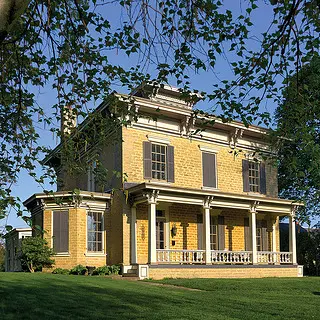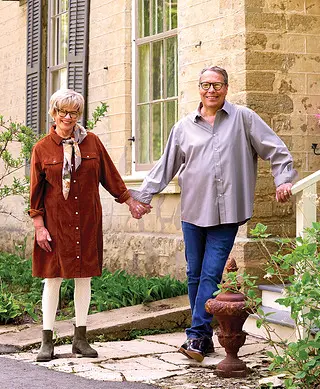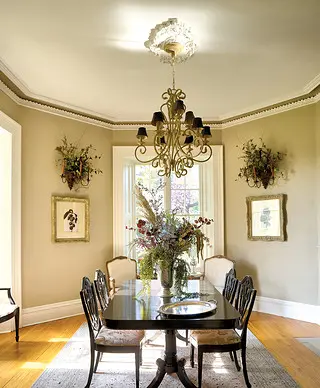
An Italianate House in Ripon, Wisconsin, Was Made to Last
From our interview with homeowners Cathylee and Steve Arbaugh
Cathylee: As we neared retirement, we began looking to move from the Chicago suburbs.
Steve: I spent a combined 40-plus years working as a buyer for national retail chains and then in brand marketing for startups to Fortune 100–500 companies. Cathylee was a salesperson and has worked in commercial and residential interior architecture and design for more than 38 years.
Cathylee: I liked Ripon, Wisconsin, because of the energy and cultural events that come with Ripon being a college town. Steven found and fell in love with the Catlin residence online.
Steve: Richard Frederick Catlin was the brother of George Catlin, the artist and author who documented Native American people and cultures. Richard and his wife, Darwina Fayette Barstow Catlin, came to Ripon in the 1840s from New England. Their second house was this work of Italianate architecture, built from 1857 to 1861. We know the builder of our house was Marcellus Pedrick.
The house had been sitting on the real estate market for two years; the agent had shown it more than 100 times. People worried about the condition of the house, which was included on the national and state Registers of Historic Places, and the cost of utilities.
The 11-room house is 4,650 square feet. On the first floor, the ceilings are 12 feet high, and the windows are 10 feet high. On the second floor, the ceilings drop to 10 feet and the windows to 8 feet. The house sits in the middle of a 1-acre lot, which is what remains of the Catlins’ original 38-acre lot.
Cathylee: The materials to build this house came from Fond du Lac, Wisconsin, about 20 miles away.
Steve: Its exterior walls are made of 15-inch-thick limestone, which sits atop a 23-inch-thick stone foundation. The wall thickness tapers as you go up. On the main house, the limestone is covered with a skim coat and stenciled to look like concrete block masonry. The back of the house, which was formerly the service quarters, is built with smaller stacked limestone and not stenciled.
Cathylee: Concrete block was viewed as more significant [than stone] at the time. Steve repainted the exterior trim, corbels, and soffits using four colors I selected, including a dark gray and a buttery yellow that complement the limestone perfectly.
Steve: We have the original shutters and windows, most of which are six-over-six, double-hung windows of single-pane glass. We also have the original wooden storm windows. The lower-level storm windows weigh 75 pounds each; upstairs, they are 55 pounds each. It’s built like a fortress.
We’ve been told that the original wood roof had a built-in gutter channel that directed rainwater into a cistern in the attic and then to the butler’s pantry through a pipe. As is typical in Italianate architecture, the roof is sloped no more than 10 degrees so it looks flat.

photo by: Matthew Gilson
Cathylee and Steve Arbaugh restored and renovated an Italianate house built between 1857 and 1861 in Fond du Lac County, Wisconsin.
Cathylee: We have a belvedere, which was used to exhaust hot air rising inside the house during the summertime. As part of our restoration and rehabilitation, we repaired the belvedere’s broken windowpanes. Now we play cards up there during thunderstorms.
The major renovations took about nine months. We started soon after we purchased the house, though you’re never finished with a house like this.
Steve: It needed repair on every level. We hired an expert in painting, plasterwork, and wallpapering who apprenticed in Germany and Austria—he has since retired. We also hired local contractors willing to tackle older homes: Heatley Electric, Atomic Plumbing, and Peace of Mind Construction. Electricity, plumbing, and running water were introduced into the house in 1930.
Stay connected with us via email. Sign up today.

photo by: Matthew Gilson
A new kitchen complements the restored spaces.
Cathylee: Our house still had fabric-wrapped wiring. Luckily, our electrician knew the house well, and he also owns an Italianate two streets over. We reworked all the rooms without damaging their design integrity, though we did change some of their uses.
Steve: Italianates typically have a formal parlor, library, and dining room. We made the parlor into our television and living room; the library into our dining room, which is perfect for parties; and the dining room into our reading room.
Cathylee: We repainted the interior with four neutral colors so anywhere you look, the rooms work together. In what’s now our dining room, we had to paint over heavy seagrass wallpaper from the 1970s. We tried to take it down, but it took the plaster with it.

photo by: Matthew Gilson
The former library now serves as a sunlit dining room.

photo by: Matthew Gilson
The Arbaughs turned the original dining room into their reading room.
Steve: The wood casing around the doors and windows was painted in the 1930s, probably to a gray. Cathylee chose to paint the trim in Clark + Kensington Designer White to brighten up the interiors. The only person who complained was our painter, who thought an antique home deserved an antique color, but he’s been back twice and says he loves the white.
Cathylee: The ceiling medallion in the main parlor is original. For the first- and second-floor hallways, we had four plaster medallions made by Mouldings, Corbels & More, based on the pattern of an existing, broken medallion. Along the ceiling, the ornamental molding looks like woodwork, but it’s heavy plaster embedded into the plaster walls. Our dining and living rooms have double ceiling moldings, and we added molding upstairs to unify the look throughout the house.

photo by: Matthew Gilson
The circa-1860 four-oil-lamp chandelier in the former parlor is likely original. It was wired to run on electricity in 1930.
Steve: The foyer and the parlor floors were carpeted until 1994. The wool carpet came from Brussels, Belgium, and it was floral on floral—very Victorian. We’ve since toured several Italianate houses in the region that had carpet; looms back then were only 4 feet wide, so people would hand-stitch 4-by-8-foot panels to create the look of wall-to-wall carpet. Now the only original wood floor—pine planks—left in the house is in the foyer because it was protected under the carpet. The rest of the house was changed to hardwoods—oak downstairs and hard rock maple upstairs—which were popular in 1930.
The original dining room has a hole in the floorboards where the homeowners could push a button with their foot under the table and ring a bell in the servants’ quarters in the back of the house.
The former parlor has two separate doors to the foyer. Like many Victorian houses, this house hosted funerals [for family members], and we believe the doors allowed receiving lines to enter and exit efficiently.
Of all our light fixtures, the circa-1860 four-oil-lamp chandelier in the parlor is the most original to the house. According to previous owners, it was attached to a pulley to lower and refill it; it was wired to run on electricity in 1930.
Cathylee: This house was once a hub of activity for the city of Ripon, bringing people together to make plans, form committees, and organize local efforts. Today we host about two events a year, such as fundraisers and parties for local organizations like the Green Lake Festival of Music. We’ve fit 45 to 65 people here comfortably.
Steve: When we open the house to tours for charity events, hundreds of curiosity seekers, design aficionados, and historians alike show up, eager to learn about its history and relationship to Ripon.
Donate Today to Help Save the Places Where Our History Happened.
Donate to the National Trust for Historic Preservation today and you'll help preserve places that tell our stories, reflect our culture, and shape our shared American experience.


